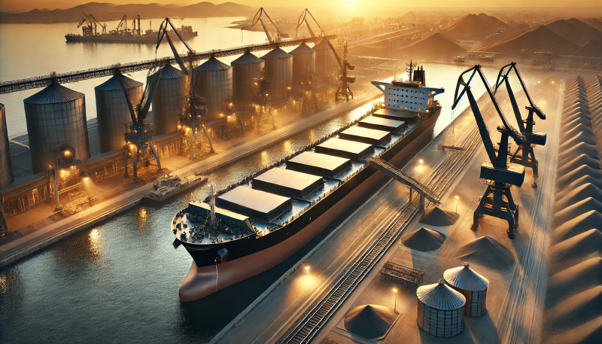Together with…

Introduction
The past five years have witnessed several remarkable investment success stories in the shipping industry, where savvy investors realized outsized returns by astutely timing market cycles and executing bold strategies. This report examines John Fredriksen’s stake in Frontline – the second of four high-profile reports, each exemplifying how private capital can achieve exceptional gains in shipping. A concluding report will follow the four cases to distil lessons and strategic considerations for investors evaluating opportunities in the shipping sector.:
- Oaktree Capital’s turnaround of Torm – a distressed product tanker company restructured in 2015 that went on to multiply Oaktree’s equity value fivefold.
- John Fredriksen’s stake in Frontline – the Norwegian shipping magnate’s holdings in a crude oil tanker operator yielded a 3.5× return amid a cyclical rebound.
- Fredriksen’s bet on Golden Ocean – a leading dry bulk carrier where Fredriksen’s increased investment paid off 4.6× over five years, culminating in a lucrative exit.
- The Coustas Family’s position in Danaos Corp. – a containership leasing company in which the founding family’s stake ballooned 14× in value thanks to a post-restructuring boom in container markets.
- Comparative Analysis of the Four Cases and Key Takeaways

Background
Frontline Ltd. is one of the world’s largest crude oil tanker companies, operating a fleet of VLCCs and Suezmax/Aframax tankers that transport crude oil internationally. Its major shareholder is John Fredriksen, a legendary Norwegian-born investor often dubbed “the tanker king.” Fredriksen has a long history in shipping, having built and restructured multiple companies over decades (from tankers to offshore drilling), and is renowned for his contrarian bets on shipping cycles.
By 2019, Frontline had only recently recovered from a challenging period in the mid-2010s when tanker rates were depressed. In fact, Frontline itself underwent a major restructuring in 2015: it merged with a spin-off (Frontline 2012) and received support from Fredriksen’s private vehicle (Hemen Holding) to stabilize its finances. By the end of that restructuring, Fredriksen – through Hemen – owned a very large stake (around 40%) of the company. Going into 2019, Frontline was leaner and better positioned, but tanker rates and sentiment were still relatively weak. This context set the stage for the value increase that followed.
Investment and Holding Details
Fredriksen’s “investment” in Frontline is not a single transaction but rather an ongoing ownership stake that he has held and managed for years. For the purpose of measuring returns, we consider his stake value from 2019 to 2024. In May 2019, Fredriksen (via Hemen Holding and associated entities) owned approximately 79.1 million shares of Frontline. At the time, Frontline’s share price hovered around $7.60 on the NYSE, making his stake worth roughly $602 million.
Despite controlling the company, Fredriksen did not significantly alter his holdings in subsequent years – he maintained roughly the same number of shares through 2024 (aside from minor dilutions or buybacks). By early 2024, those shares had appreciated markedly.
Frontline’s New York–listed stock traded above $26 per share in the first half of 2024 (indeed hitting its highest levels since 2012), valuing Fredriksen’s 79.1 million shares at approximately $2.09 billion. In other words, over five years the stake’s value increased about 3.5×, translating to an approximate 28–30% IRR for that period.
| Investment Figures (Approximate, rounded) | 2019 | 2024 (Post-Rebound) |
|---|---|---|
| Stake Held (Million Shares) | 79.1 | 79.1 |
| Stake Market Value | $602 million | $2.09 billion |
| Share Price (NYSE) | $7.62 | $26.40 |
| 5-year Equity Multiple | – | 3.5× increase |
| Annualized IRR | – | 28% |
Key Success Factors
Fredriksen’s Frontline success story was driven by adept cycle management and strategic moves:
Tanker Market Cycles: The crude tanker sector is notoriously cyclical, and 2019 marked a cyclical low point. Global oil demand growth had slowed, OPEC cuts in 2017–18 reduced seaborne volumes, and fleet oversupply kept rates modest. However, Fredriksen is known for weathering downturns; instead of exiting, he held his position (and even advocated for industry consolidation to prepare for a turn).
His conviction paid off when the cycle turned sharply. In late 2019 and again in 2020, unforeseen events caused tanker rates to spike. Notably, in spring 2020, the COVID-19 shock led to a crude glut and a scramble for floating storage – spot rates for VLCC supertankers briefly surged above $200,000/day (an unprecedented level), yielding windfall profits for owners like Frontline. Although that spike was temporary, with rates normalized later in 2020, another upswing occurred in 2022: the post-pandemic economic recovery and the fallout from the Ukraine war (with sanctions on Russian oil) resulted in longer transport distances and dislocations in crude flows.
Frontline’s vessels were suddenly in high demand, and charter rates in late 2022 hit multi-year highs (VLCCs again earning $80k+/day at peaks). Over 2019–2024, crude tanker indices rose dramatically – an index of tanker stock prices gained hundreds of percent – and Frontline rode that wave. Fredriksen’s stake value growth essentially mirrors this macro cycle: he held through the lean years so as to be fully exposed to the upside when it arrived.
Opportunistic Fleet Expansion: A hallmark of Fredriksen’s strategy is to acquire assets counter-cyclically, and Frontline executed such moves in this period. In late 2019, anticipating stronger markets ahead – partly due to new IMO 2020 fuel regulations and tighter supply – Frontline struck a major deal with commodity trader Trafigura to acquire 10 modern Suezmax tankers. The ~$675 million transaction (closed in early 2020) was partly financed with Frontline shares (giving Trafigura ~8.5% equity) and partly with cash from new debt/leasing.
This bold expansion at a time of subdued prices proved prescient – the vessels were delivered just in time to benefit from the early 2020 rate spike and beyond. In effect, Fredriksen leveraged Frontline’s balance sheet and his reputation to grow the fleet when asset values were low. The acquired ships, being nearly new, also improved Frontline’s fleet age profile and fuel efficiency. This asset play paid off handsomely: as tanker earnings and ship values rose by 2021–2022, the value of Frontline’s enlarged fleet (and thus its equity) increased substantially.
Geopolitical Windfall – Russian Oil Realignment: The sanctions on Russian crude in 2022 forced global oil trade to recalibrate. European importers replaced short-haul Russian barrels with long-haul shipments from the Middle East, U.S., West Africa, etc., while Russia had to send its oil to Asia on longer voyages. This increased the average voyage distance and effectively “used up” more tanker capacity for the same volume of oil – a boon for tanker owners.
Frontline, with its primarily spot-trading fleet, capitalized on the elevated demand. The company reported robust earnings for 2022 and 2023, paid substantial dividends, and its stock significantly outperformed the broader market. Fredriksen’s conviction that “tanker markets benefit from dislocations and shocks” was validated once again. It’s worth noting that while such geopolitical events are unpredictable, Frontline’s positioning (strong liquidity, modern fleet, and global operating platform) meant it could immediately take advantage when the opportunity arose.
Financial Discipline and Leverage Management: Unlike the pre-2008 era when Frontline was extremely highly leveraged (and paid out nearly all earnings as dividends), the company’s post-2015 incarnation was more financially conservative. Frontline maintained a moderate debt level – enough to finance fleet growth, but not so high as to jeopardize the company in a downturn.
By 2019, Frontline’s balance sheet debt was structured via sale-leasebacks and loans at relatively low interest rates, and its debt-to-assets ratio was reasonable. This lower break-even point allowed Frontline to survive the weaker years without dilutive equity raises (aside from strategic deals like Trafigura’s). Consequently, Fredriksen’s stake was not diluted and fully participated in the recovery.
The new financial playbook in shipping (emphasizing sustainability over maximum leverage) helped ensure that equity holders reaped the benefits of the upcycle rather than creditors. Frontline’s prudent approach – often influenced by Fredriksen’s own guidance and the presence of strong finance teams – set the stage for a solid equity return once revenue surged.
Outcome
By 2024, Frontline was not only experiencing high stock prices but also undertaking strategic moves to enhance shareholder value. The company initiated an equity offering program, taking advantage of the strong stock price to raise additional capital for fleet renewal or dividends, and consistently paid quarterly dividends reflecting its policy of returning cash in good freight markets.
Fredriksen’s stake value at $2.09 billion (3.5× its 2019 value) does not include these dividend flows – which were significant (Frontline, for instance, declared an $0.30/share dividend in Q1 2023 and additional payouts later). Thus, Fredriksen’s total economic gains (capital appreciation plus dividends received) were even higher.
It’s important to note that Fredriksen’s involvement in Frontline is strategic and long-term; unlike a typical private equity investor, he did not “exit” once the stake tripled. However, he did consider transformative transactions to unlock value – most notably, an attempted merger with rival Euronav in 2022–23 to form a tanker behemoth.
Fredriksen amassed a stake in Euronav and proposed merging it with Frontline, aiming to create economies of scale and ultimately drive valuations higher. Although that deal fell through in early 2023 (due to opposition from Euronav’s other major shareholders), the episode underscored Fredriksen’s focus on value creation: he was willing to consolidate the industry to sustain gains. Even without the merger, Frontline proceeded to acquire some modern VLCCs from Euronav later, and the industry remained in a strong earnings environment.
By maintaining his large position, Fredriksen signaled confidence in Frontline’s prospects. Indeed, as of late 2024, he remains the controlling shareholder, and any future monetization would likely be gradual or via strategic sales. The 3.5× return achieved over five years demonstrates how an insider with deep sector knowledge can extract substantial value by holding through volatility and making aggressive moves when others are fearful. Fredriksen effectively acted as his own private equity, using patient capital to capture the full cycle of the tanker market.
Strategic Insights
The Frontline case provides a template for cycle-driven value investing. For private markets investors, a few lessons emerge: Firstly, in cyclical industries, buy-and-hold can outperform frequent trading – Fredriksen’s steadfast hold from 2019 to 2024 allowed him to capture a full upswing. PE funds with longer duration or “evergreen” capital could similarly benefit from not being forced to exit too early in a cycle.
Secondly, sector expertise and leadership matter; Fredriksen, being an industry veteran, could anticipate trends (like ordering IMO 2020-compliant ships, or seizing a merger opportunity) that a purely financial investor might miss. Partnering with or backing industry experts may be key to unlocking value in shipping investments.
Thirdly, capital structure discipline is crucial – Frontline’s lower leverage ensured survival and positioned it to seize opportunities (like the Trafigura deal) in a downturn. This aligns with modern practice of avoiding over-leveraging companies in highly volatile sectors.
Finally, exit flexibility is noteworthy: while Fredriksen hasn’t fully exited, he demonstrated openness to strategic deals (a form of exit) to crystallize value. Investors in shipping should similarly plan multiple avenues for exit – whether IPOs, mergers, or block trades – depending on market conditions. The Frontline story, in summary, showcases the rewards of marrying cycle savvy with strategic action, yielding a strong 3.5× return that validates the high-risk, high-reward nature of tanker investing.
Key Findings On All Four Investment Cases
The stellar outcomes from the featured shipping investments showcase what is possible in this volatile sector – five-year IRRs up to ~70% and multiples over 10× are virtually unheard of in most industries, yet were achieved here. Private markets investors can indeed reap such rewards, but the journey requires a solid stomach, deep insight, and sometimes a bit of luck with external events.
Shipping should be approached as a special situations play: it’s not a fit for every portfolio, but under the right circumstances, it can dramatically boost returns. The lessons in these four cases boil down to a few guiding principles: buy low, fix what’s broken, ride the wave, and sell high. Those are easy to say, harder to do – but as the Oaktrees and Fredriksens show, when executed well, the payoff is well worth it.
For private equity professionals evaluating shipping, the implication is not to shun the sector’s volatility, but to harness it. With disciplined strategy and timing, shipping investments can complement private market portfolios by providing uncorrelated, large-scale gains that few other industries can match.
The key is respecting the unique dynamics of maritime markets – treating cycles as king, managing risk fiercely, and being ready to both seize opportunities and exit decisively. If done right, the result can be transformational, turning distressed ships into treasure troves and vindicating the bold contrarian investor. In the cyclical seas of shipping, fortune favours the prepared – and as these great investment stories illustrate, the rewards for preparedness and courage can be truly spectacular.
We invite you to join us again in our next installment, “3. Fredriksen’s bet on Golden Ocean”, as we continue to explore the topic and provide further insights into this area of study.
Disclaimer
Index:
Data Room AccessData room access is available only for accredited and institutional investors due to FCA permissions.
To gain access, click and fill out the following form. Our compliance team will grant you access within 24 hours.



